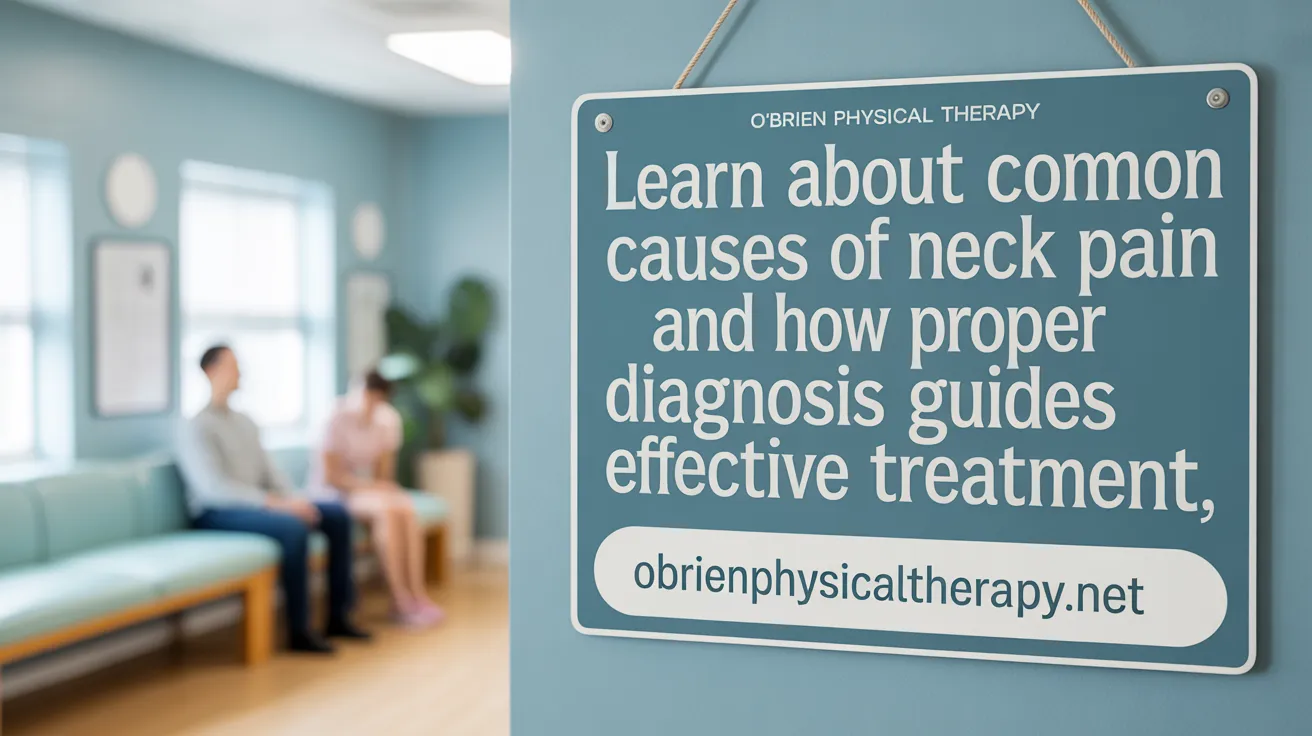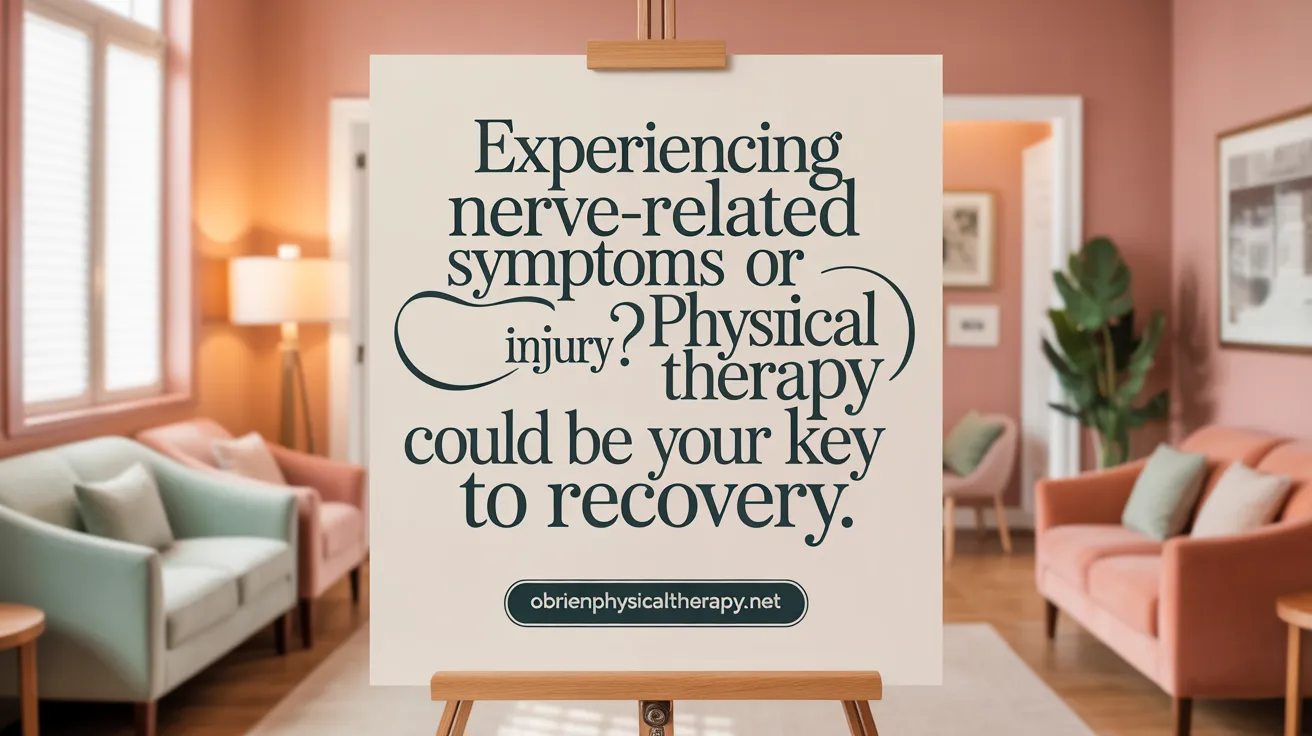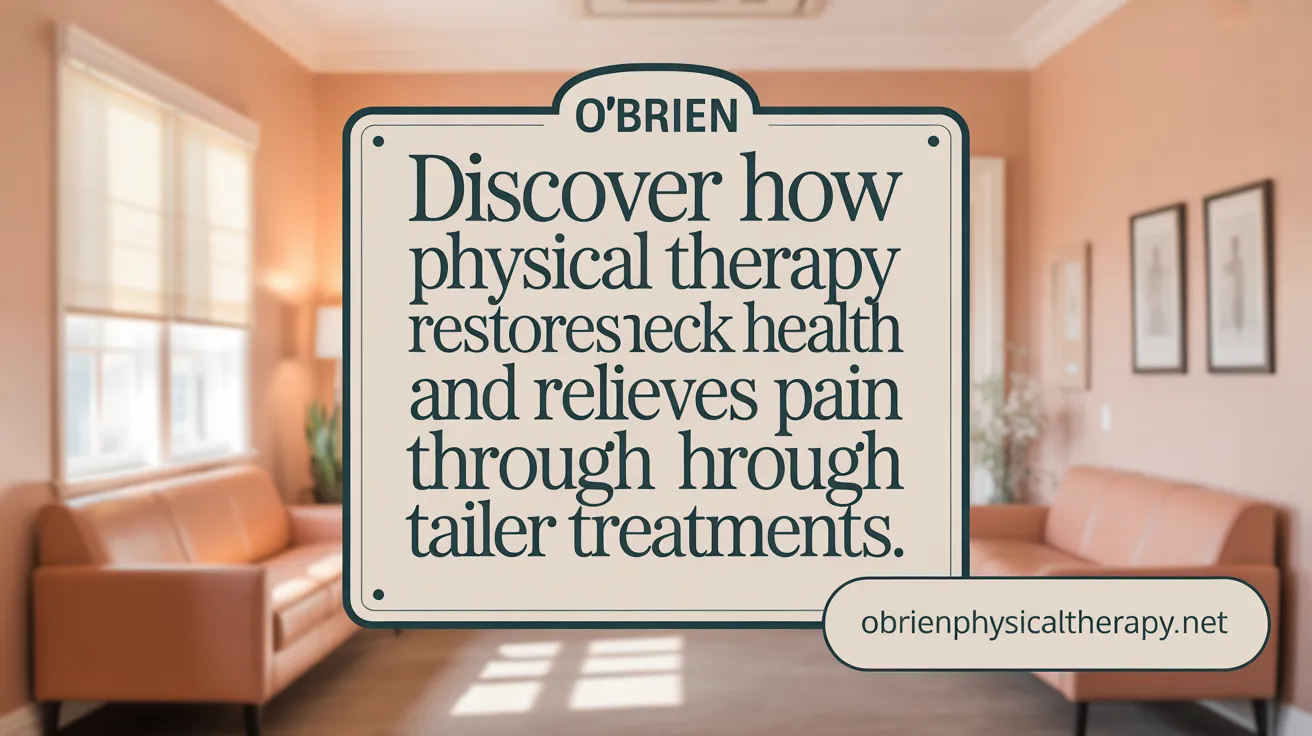Why Knowing When to Seek Help Matters
Neck pain is a common complaint that affects millions of people worldwide at some point in their lives. While many instances of neck discomfort resolve with simple self-care, certain symptoms and conditions indicate that professional physical therapy is necessary. Early intervention with physical therapy can prevent chronic pain, improve mobility, and enhance quality of life. This article outlines when you should consider consulting a physical therapist for neck pain, the symptoms and signs to watch for, common causes, diagnostic approaches, and what physical therapy entails for effective treatment.
Recognizing When to Consult a Physical Therapist for Neck Pain

When should one seek professional help or consult with a physical therapist for neck pain?
Neck pain that lasts longer than a week despite self-care, worsens over time, or significantly impacts daily activities indicates that professional help is needed. If your neck pain limits your ability to perform usual tasks such as driving, working, or sleeping, it’s advisable to see a healthcare provider.
Signs like reduced neck mobility, pain radiating into shoulders, arms, or hands, or numbness and weakness suggest nerve involvement, which requires specialized assessment and treatment. Especially after injury or accident, early physical therapy can help support recovery and prevent long-term issues.
Moreover, if your pain is severe, accompanied by headaches, dizziness, nausea, or does not improve with over-the-counter medications, seeking professional evaluation is essential. Timely intervention with a physical therapist can aid in restoring neck function, reducing pain, and preventing chronic problems.
Understanding when to seek care ensures you receive the right treatment promptly, potentially avoiding unnecessary procedures or prolonged discomfort. If your neck pain persists beyond a week or interferes with your daily life, consulting a physical therapist is the next critical step for effective management.
Key Symptoms and Signs Indicating the Need for Physical Therapy

What are the common symptoms and signs indicating the need for physical therapy for neck pain?
Recognizing when neck pain requires professional intervention is essential for effective treatment. Common symptoms that suggest the need for physical therapy include persistent aching, sharp or stabbing pain, or burning sensations that originate in the neck and may radiate down to the shoulders, arms, or hands.
Patients often report reduced ability to turn, tilt, or look up and down, indicating limited neck mobility. Muscle stiffness, spasms, and weakness in the upper limbs are additional signs pointing to a need for evaluation.
Headaches frequently accompany neck pain, especially if they are frequent or severe. Discomfort that worsens with certain movements or positions signifies that conservative therapy might help.
In more serious cases, symptoms like numbness or tingling in the shoulders or arms, or pain that radiates into the limbs, suggest nerve involvement. These signs often indicate nerve compression, such as cervical radiculopathy, which benefits from targeted physical therapy.
Severe symptoms such as pain following an accident, loss of bladder or bowel control, or significant weakness in the limbs necessitate urgent medical attention. Such signs can indicate serious underlying conditions requiring immediate care.
Overall, if neck pain persists more than a few days, begins to interfere with daily activities like driving or sleeping, or worsens over time, consulting a healthcare professional is advised. Early assessment helps in designing appropriate treatment plans to manage symptoms and prevent chronic issues.
For more detailed information about symptoms that indicate the need for physical therapy in neck pain, you can search for "Symptoms that indicate need for physical therapy in neck pain."
Understanding Causes and Diagnostic Approaches in Neck Pain

What causes neck pain and how is it diagnosed to determine the need for treatment?
Neck pain can stem from various causes, including muscle strain caused by poor posture or sudden movements, injuries like whiplash from accidents, degenerative issues such as osteoarthritis or spinal stenosis, herniated discs, and nerve compression.
In some cases, neck pain may result from underlying health problems like infections, tumors, or other serious conditions. Recognizing symptoms like weakness, numbness, neurological deficits, or severe pain helps in assessing the seriousness of the issue.
Diagnosis typically starts with a comprehensive medical history to understand when the pain began, its nature, and any associated symptoms. Physical examinations focus on movement, strength, reflexes, and signs of nerve involvement.
Imaging tests like X-rays are often used to detect structural problems such as bone spurs or fractures. MRI scans provide detailed views of soft tissues, nerves, and discs, which are crucial if nerve compression or herniated discs are suspected.
Sometimes, additional assessments such as electromyography (EMG) are performed to evaluate nerve function and pinpoint nerve root issues. Urgent medical evaluation is necessary if neck pain is severe, worsens quickly, or occurs alongside symptoms like loss of bowel or bladder control.
Understanding these causes and employing appropriate diagnostic tools allow healthcare providers to develop targeted treatment plans, ranging from physical therapy and medications to more urgent surgical options if needed.
Below is a table summarizing common causes, symptoms, and diagnostic methods:
| Cause | Typical Symptoms | Diagnostic Approach |
|---|---|---|
| Muscle strain or poor posture | Stiffness, localized pain, worse after activity | Physical exam, patient history |
| Injury (whiplash, trauma) | Sudden pain, restricted movement | X-ray, physical examination |
| Degenerative conditions | Chronic pain, stiffness, radiating pain | MRI, X-ray |
| Herniated disc or nerve compression | Radiating pain, numbness in limbs, weakness | MRI, EMG |
| Serious underlying diseases | Severe pain, neurological deficits | Blood tests, MRI, further neurological testing |
Timely diagnosis facilitates effective management, helping prevent chronic issues and restore neck function.
Specific Symptoms and Conditions Suggesting the Necessity of Physical Therapy

What symptoms or conditions specifically suggest that physical therapy is necessary for neck pain?
Many signs indicate that seeking professional help from a physical therapist is advisable for neck pain. Persistent or worsening pain that does not improve after a few days, especially when accompanied by stiffness or reduced neck mobility, is a significant indicator. If you experience difficulty turning or tilting your head, or pain that radiates into the shoulders, arms, or hands, it may involve nerve irritation, which physical therapy can help address.
Neurological symptoms such as numbness, tingling, or weakness in the arms or hands also point to nerve compression, like cervical radiculopathy. These conditions suggest that targeted interventions could alleviate nerve pressure and restore function.
Neck injuries resulting from accidents, sports, or sudden movements benefit from early physical therapy to facilitate recovery and prevent chronic complications. Furthermore, recurrent neck stiffness, poor posture, or pain that limits daily activities like driving, working at a computer, or sleeping should prompt consultation.
In addition, if pain persists longer than a week despite self-care, or if neurological signs such as headaches, dizziness, or nausea accompany the pain, professional assessment is recommended. Physical therapy aims to improve neck strength, flexibility, and posture, which can significantly reduce pain and prevent future episodes.
Note: While most neck pain is harmless and improves with conservative treatments, cases involving severe symptoms, underlying health conditions, or signs of serious injury require urgent medical attention and may not benefit immediately from physical therapy. Certain conditions, such as instability, fractures, or tumors, need specialized care beyond physical therapy.
How Physical Therapy Helps: Treatments and Goals

Passive and active physical therapy methods
Physical therapy for neck pain includes both passive and active treatments. Passive therapies involve modalities like heat and cold therapy, massage, ultrasound, electrotherapy, and cervical traction. These methods work without requiring effort from the patient and are aimed at reducing pain and inflammation.
Active therapies focus on exercises that strengthen the neck and surrounding muscles. Common exercises include chin tucks, neck rolls, head tilts and turns, and overall movement practices designed to restore flexibility and stability in the neck region.
Typical therapy session structure
A standard physical therapy session usually lasts at least 45 minutes, where practitioners evaluate your neck’s range of motion, strength, and pain levels. Treatment may involve manual therapy, guided exercises, and education on posture and activity modification. After each session, patients generally resume their daily activities without significant downtime.
Goals of therapy (pain relief, motion restoration, strengthening)
The primary goals of physical therapy are to reduce neck pain and stiffness, restore normal neck mobility, and strengthen the neck and core muscles. It also targets reducing muscle spasms and preventing future episodes of neck pain. Achieving these improvements helps individuals perform daily tasks more comfortably and minimizes the risk of recurrence.
Home exercises and posture education
Physical therapists often prescribe personalized home exercise routines, including stretches and strengthening exercises like chin tucks and neck tilts. Education on maintaining good posture—such as proper sleep positions and ergonomic workspace setup—is integral to prevent ongoing strain. These practices support long-term health and reduce the likelihood of future neck issues.
| Treatment Type | Main Focus | Typical Examples | When Recommended |
|---|---|---|---|
| Passive therapies | Reduce pain, inflammation, and muscle tension | Heat/cold, massage, ultrasound, electrotherapy | During initial treatment or when pain limits movement |
| Active therapies | Improve strength, flexibility, and function | Neck exercises, posture correction | To restore movement and prevent relapse |
| Education and home exercises | Enhance posture, habits, and self-management | Stretch routines, ergonomic advice | As ongoing support after formal therapy sessions |
Preventive Measures and When to Seek Urgent Care
How can I prevent neck pain through lifestyle?
Maintaining good posture is essential to prevent neck pain. Avoid slouching or hunching over your computer or phone, and remember to take regular breaks to stretch and move. Proper sleep positioning, such as using a supportive pillow and avoiding sleeping on your stomach, can also help keep your neck healthy. Staying active with neck and shoulder stretches, and avoiding heavy shoulder loads or carrying bags on one shoulder, reduces strain.
What signs require urgent medical evaluation?
Seek immediate medical attention if you experience severe neck pain that interferes with daily activities, especially after an accident or fall. Watch for symptoms like loss of bowel or bladder control, weakness in limbs, persistent headaches, dizziness, nausea, or vision changes. Sudden numbness, tingling, or weakness extending down arms or legs also require urgent care.
Why is timely intervention important to prevent chronic problems?
Addressing neck pain early, within three weeks of onset, often leads to shorter recovery times. Delay in treatment can lead to persistent pain, reduced mobility, and further nerve involvement. Professional assessment helps identify underlying causes and prevents neck issues from becoming long-term or complicated.
When does neck pain affect vital functions?
Neck pain that compromises vital functions includes symptoms like difficulty breathing, severe weakness, or paralysis. If the pain occurs with new or worsening neurological symptoms, or if it is accompanied by headaches, dizziness, or nausea, consult a healthcare professional promptly. Immediate care is necessary if pain is intense or if it results from trauma affecting the spinal cord.
| Prevention Tips | Signs to Watch For | Urgent Care Indicators | Impact on Daily Life |
|---|---|---|---|
| Maintain good posture | Severe pain post-accident | Loss of bowel or bladder control | Disrupts sleep or work |
| Regular neck stretches | Persistent headaches | Limb weakness or numbness | Limits movement or daily activities |
| Use supportive pillows | Sudden neurological changes | Difficulty breathing | Affects ability to perform daily tasks |
| Avoid heavy shoulder loads | Dizziness or nausea | Pain that it is unmanageable | Can cause long-term discomfort |
Understanding these prevention and warning signs helps you take action early, ensuring neck health and reducing the risk of serious complications.
Taking Action for Neck Health
Recognizing when neck pain warrants professional attention is crucial to preventing long-term discomfort and disability. Persistent pain, neurological symptoms, impaired movement, or pain following injury are clear signals to consult a physical therapist. Through targeted therapies, physical therapy offers a safe, effective alternative to surgery or prolonged medication use and helps restore function and quality of life. Early evaluation and intervention not only reduce pain but also promote recovery and prevent recurrence. If you experience ongoing or worsening neck pain, seek guidance promptly to ensure the best outcomes for your neck health.
References
- When to See Your Physical Therapist for Neck Pain
- Physical Therapy for Neck Pain: What to Expect
- Understanding Neck Pain
- Neck Pain: 6 Common Causes and Treatments
- When To See a Physical Therapist for Neck Pain: PT vs. ...
- When to Seek Professional Physical Therapy For Neck Pain
- Treating Back & Neck Pain With Physical Therapy
- Physical Therapist's Guide to Neck Pain
- How Does Physical Therapy Help Neck Pain? What to Expect
- 5 Ways to Relieve Your Neck Pain, from a PT
